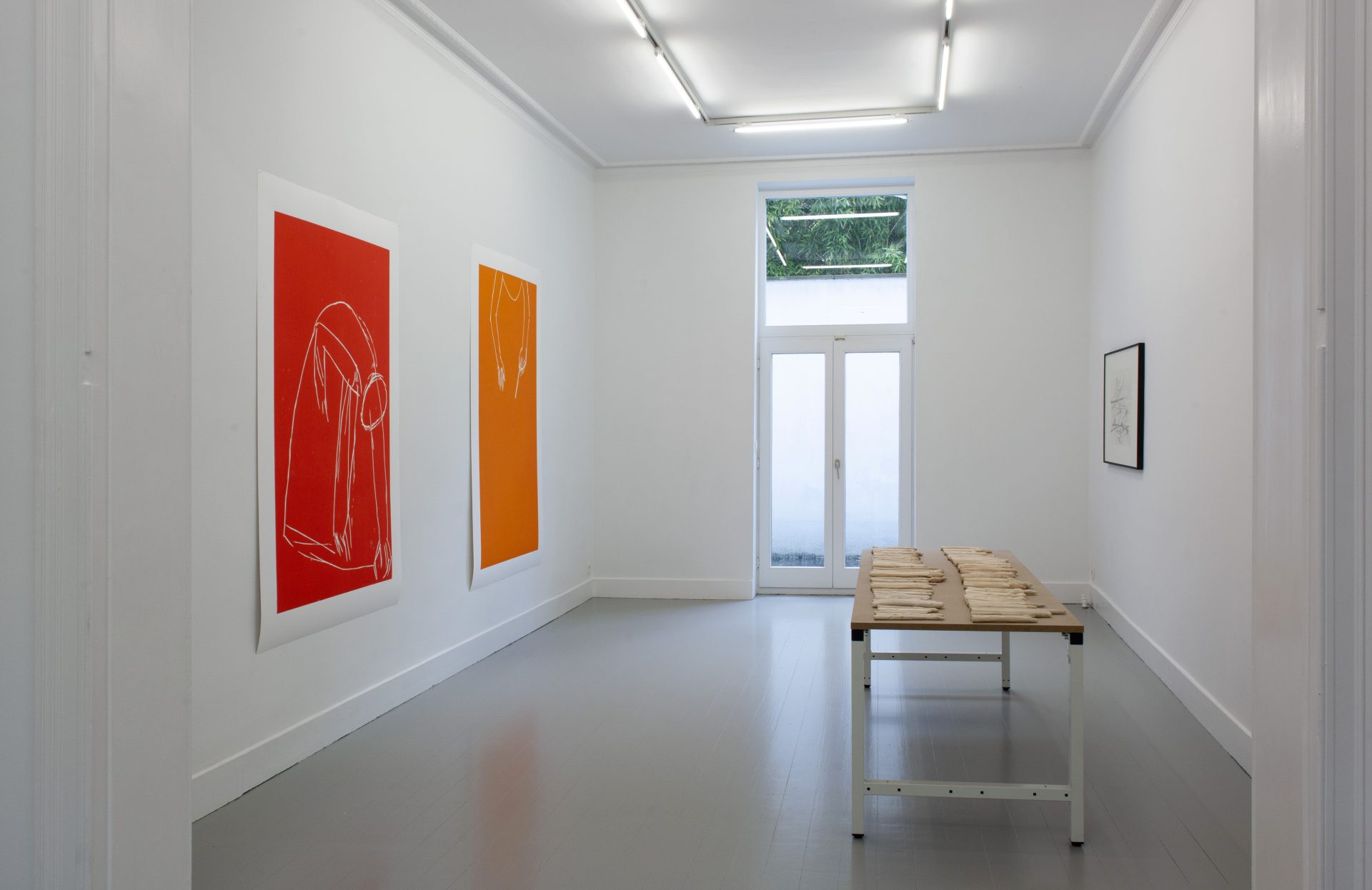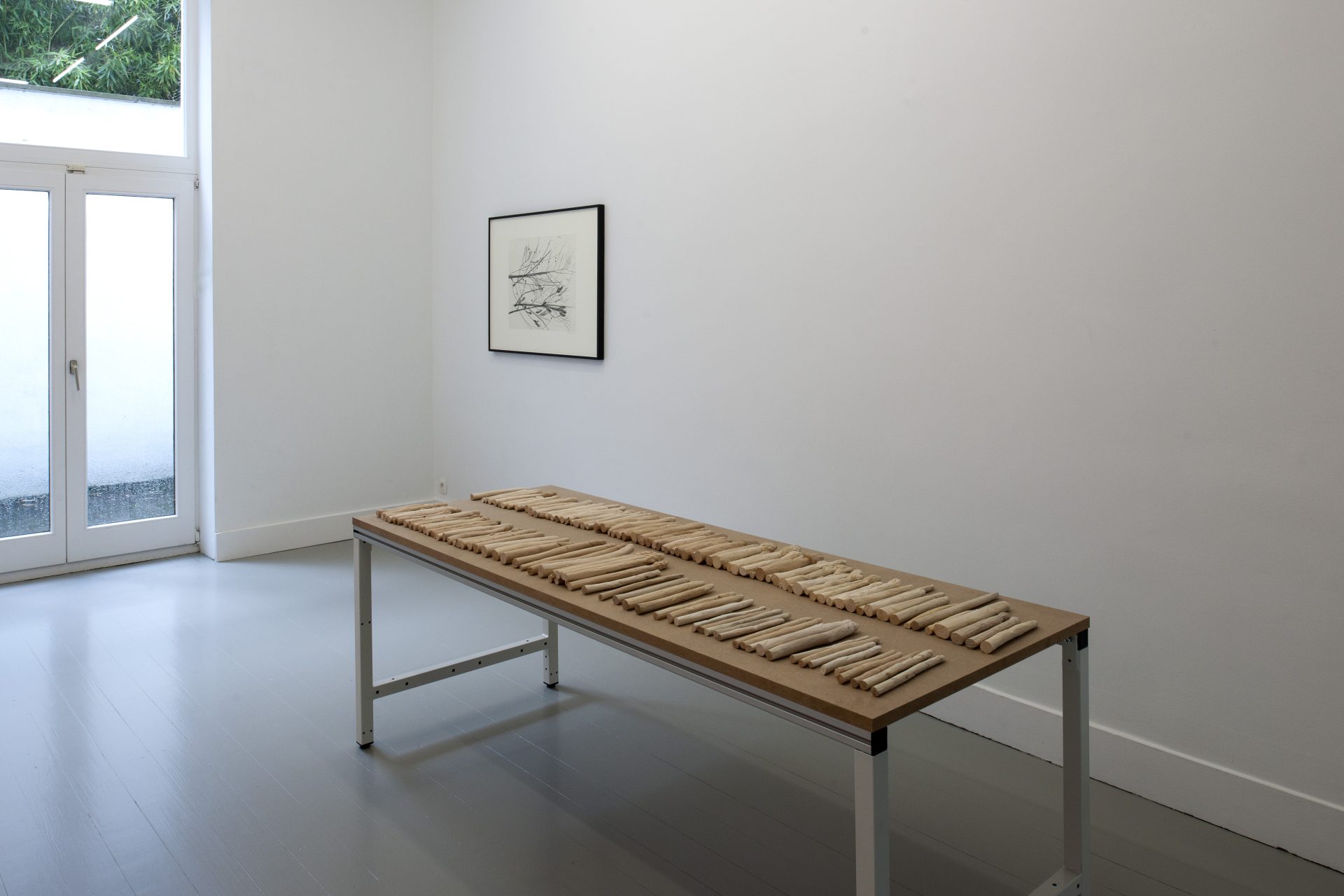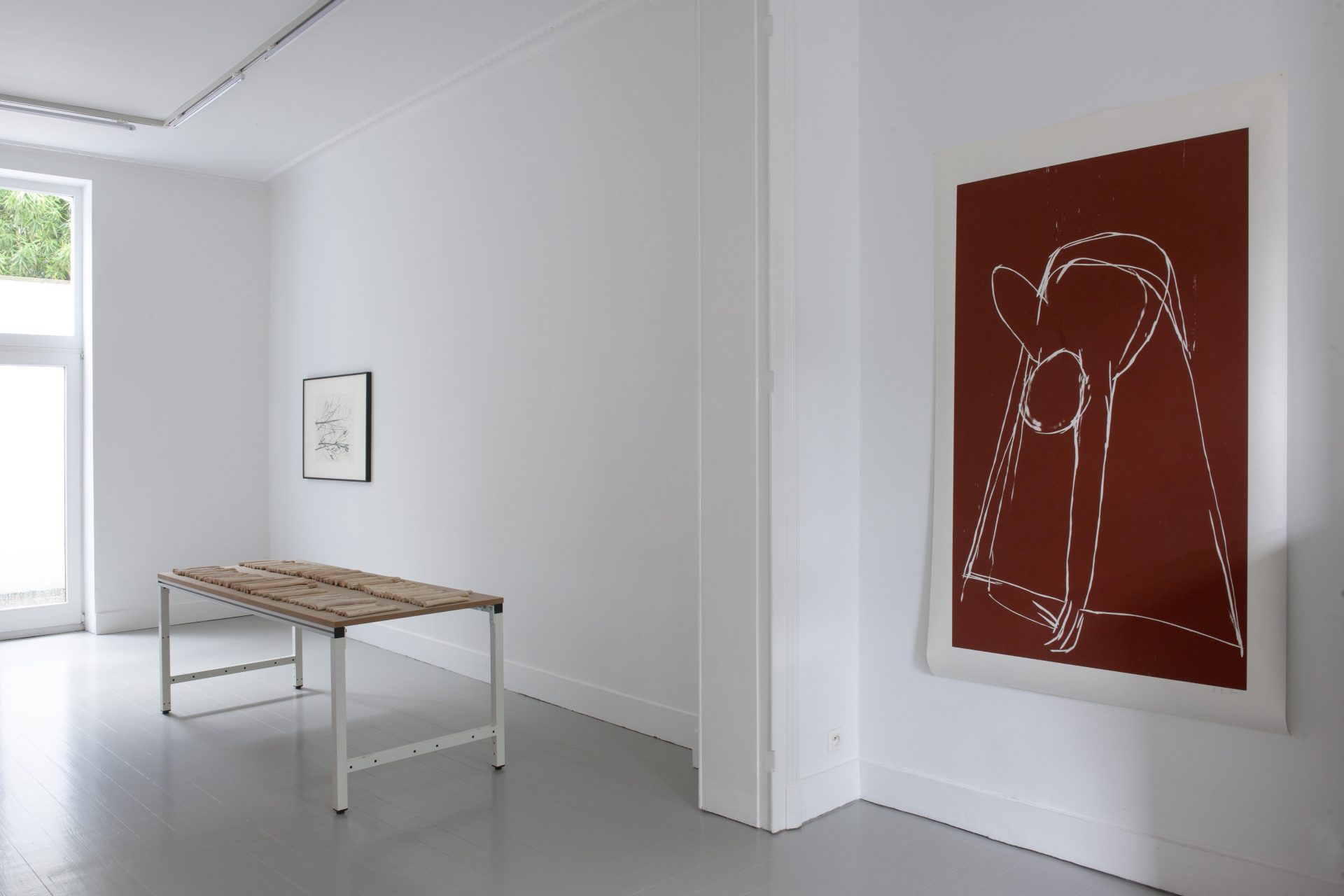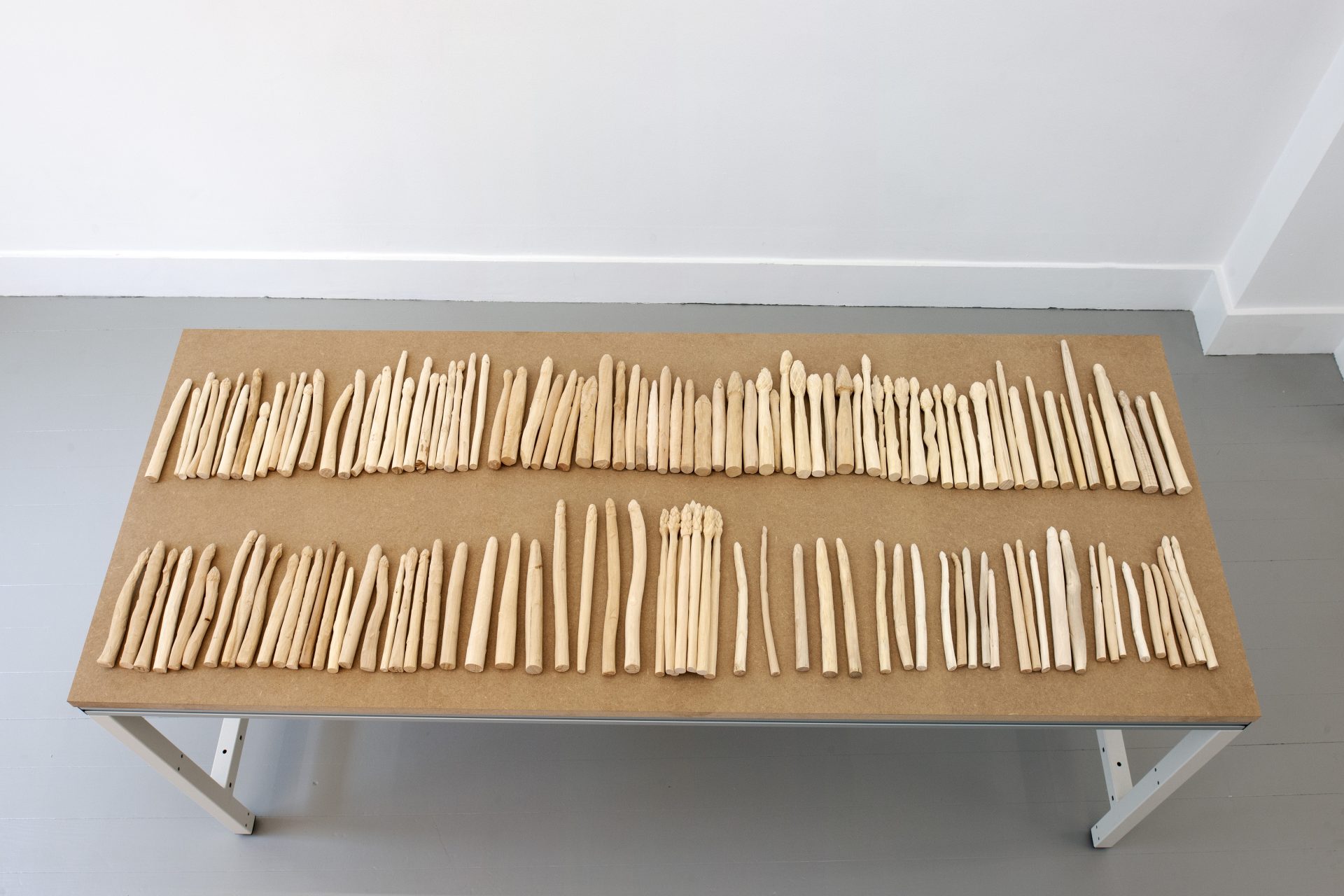04/06/22 - 23/07/22
Andrea Büttner
Part 1: Asparagus Harvest



Asparagus Harvest, installation views at Jan Mot, 2022 (from left to right, from top to bottom: Andrea Büttner, Erntender, 2021, woodcut on paper, unframed, 203 x 115 cm, unique; Andrea Büttner, Erntende, 2021, woodcut on paper, unframed, 188 x 113 cm, unique; Andrea Büttner, Asparagus Harvest (plate 7), 2021, etching, frame, numbered and signed by the artist, 70 x 100 cm (paper), 74,4 x 104,2 cm (frame), edition of 5 and 2 A.P.; Andrea Büttner, Spargel (Asparagus), 2021, 141 asparagus carved from wood on table, 73 x 200 x 75 cm (table), unique)
This text was written by Patrizia Dander in the context of Triebe, Andrea Büttner’s solo show presented at Galerie Tschudi (CH) in 2021.
In the spring of 2020, Andrea Büttner began to observe and draw the white asparagus harvest in the countryside around Berlin. In classic plein-air style, she observed and sketched the workers during the physically demanding labour of harvest, which is mostly done by hand to this day. Cultivated in row upon row of long mounds of soil, protected from cold and sunlight with heavy plastic sheets, white asparagus grows entirely under the earth. Working with speed and precision, experienced harvesters first use two fingers to uncover the sensitive asparagus tips that peek out of the compact soil. They dig touncover the shoots and snap the shaft from the root with an asparagus knife, about 20 cm below the surface. They then use a trowel to backfill and smooth the soil to allow new shoots to grow from the root, recovering the mound with plastic sheeting. These steps of labour, which are all carried out in a stooped position—with a straight back and slightly bent knees—are repeated meter by meter, row by row, for a period of 10 weeks, which is how long the harvest usually takes. The sketch books, woodcuts, etchings, carvings, and ceramic table-top sculpture in the exhibition Triebe (German for “shoots” or “spears”, but also “drives”) all reference the asparagus harvest. Starting with numerous drawings that roughly outline the various scenes and steps of work involved, over the course of the past year Andrea Büttner has created a dense and complex group of works dedicated to various impressions of the asparagus harvest: from the functional, geometric shape of the mounds and the contours of the seasonal workers’ bent over bodies, to details such as their hands penetrating the earth.
This last detail is the focus of the seven-part series of etchings Spargelernte (Asparagus Harvest, 2021). A filmic sequence of close-ups of hands at work—interrupted by a single sheet that shows the tender growth of asparagus fern after the harvest—builds an unsettling sense of intimacy. We follow the hands as they breach the surface of the earth, uncover the phallus-like asparagus spear, grasp it with one hand and finally cut it with a long knife. The voyeurism involved in watching other people at work makes the etchings into uncomfortable images. The details of the asparagus tips and fingers draw the gaze in an almost pornographic manner, placing us in the position of unbidden spectators. At the same time they allow to take the perspective of the workers themselves—it is almost as if we are watching our own hands at work. This displacement, which clearly has a political dimension, is important for understanding Büttner’s exhibition.
Germany is not only the largest area of asparagus cultivation in Europe (1), asparagus also takes up the largest acreage of all vegetables cultivated in Germany. In the spring of 2020, following travel bans on seasonal workers due to the Coronavirus, the asparagus harvest became the linchpin of vehement discussions: news reports about asparagus farmers in danger of losing their harvests without seasonal workers from eastern Europe, contrasted with reports about the enhanced risk of infection for workers in cramped living conditions and the (already well-known) low wages and hard labour conditions (2). The asparagus harvest came to stand as an emblem for a critique of labour migration within Europe, and became an ethical issue—for who would continue eating German asparagus following these insights?

Asparagus Harvest, installation view at Jan Mot, 2022, (Andrea Büttner, Erntender, 2021, woodcut on paper, unframed, 203 x 115 cm, unique; Andrea Büttner, Erntende, 2021, woodcut on paper, unframed, 188 x 113 cm, unique)

Asparagus Harvest, installation view at Jan Mot, 2022, (Andrea Büttner, Asparagus Harvest (plate 7), 2021, etching, frame, numbered and signed by the artist, 70 x 100 cm (paper), 74,4 x 104,2 cm (frame), edition of 5 and 2 A.P.; Andrea Büttner, Spargel (Asparagus), 2021, 141 asparagus carved from wood on table, 73 x 200 x 75 cm (table), unique, Andrea Büttner, Erntende, 2021, woodcut on japanese paper, unframed, 188 x 113 cm, unique)

Asparagus Harvest, installation view at Jan Mot, 2022, (Andrea Büttner, Spargel (Asparagus), 2021, 141 asparagus carved from wood on table, 73 x 200 x 75 cm (table), unique)

Asparagus Harvest, installation view at Jan Mot, 2022, (Andrea Büttner, Erntende, 2021, woodcut on japanese paper, unframed, 188 x 113 cm, unique; Andrea Büttner, Asparagus Harvest (plate 5), 2021, etching, frame, numbered and signed by the artist, 70 x 100 cm (paper), 74,4 x 104,2 cm (frame), edition of 5 and 2 A.P.)
-
1. The volume of Asparagus cultivation in Germany is more than double that of Spain or Italy, see: http://www.fao.org/faostat/en/#data/QC; accessed online 03.07.2021.
2. See https://www.theguardian.com/world/ commentisfree/2020/apr/16/western-eu-rope-food-east-european-workers-corona-virus?CMP=Share_iOSApp_Other&fbc lid=IwAR38fPd-Q9BFOLI0zzAliPnAzb-buM_wS2xmRW-XkNxfXNLweV093B AQLrwDI; accessed 03.07.2021.